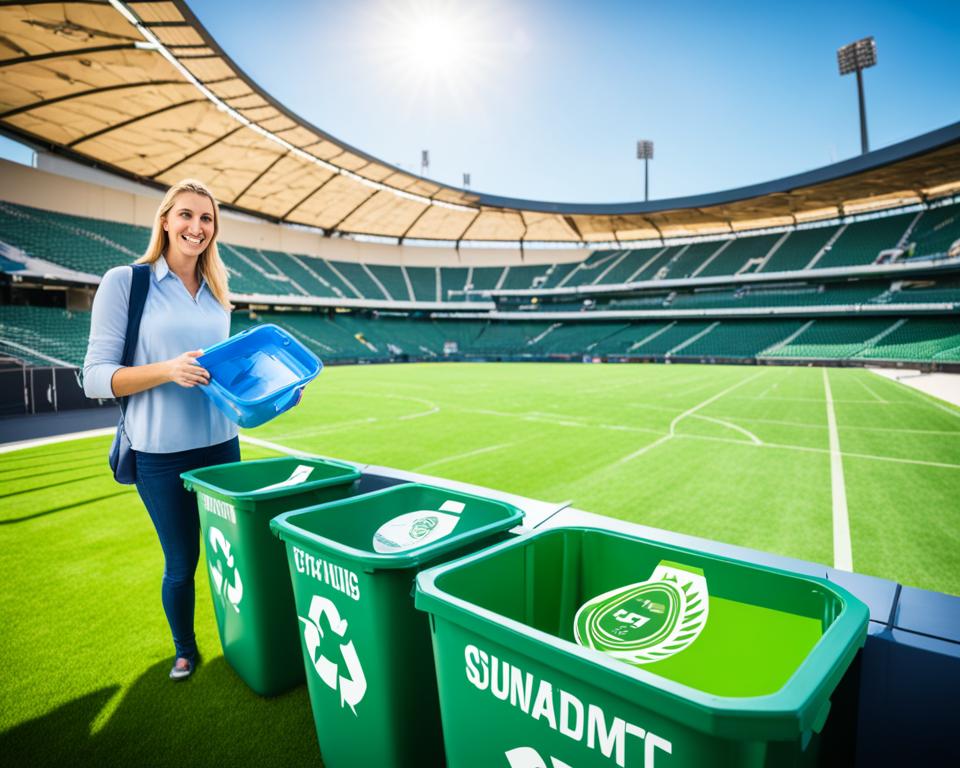The world of sports is not merely about the thrill of competition and the pursuit of excellence, but also about the impact it can have on our environment. As we face increasing environmental challenges, the intersection of sports and sustainability becomes crucial. This article delves into how athletics can promote sustainability, highlighting various aspects from athlete endorsements to stadium constructions, community initiatives, and technological advancements. The article emphasizes the importance of leveraging the influence and resources of the sports industry to drive significant environmental change and create a more sustainable future.
From eco-friendly sports equipment and sustainable sports facilities to green sporting events and athlete environmental activism, the sports industry is poised to lead the charge in addressing the sports industry carbon footprint and tackling sports and climate change. This article will explore the innovative solutions and pioneering initiatives that are transforming the landscape of athletics, paving the way for a more energy-efficient and plant-based athlete nutrition future.
Driving Forces Behind Greening Sports
Across college campuses, student environmental activism has emerged as a powerful catalyst for driving sustainability initiatives within the sports domain. At the University of Colorado Boulder (CU-Boulder), students have played a pivotal role in uniting the athletics department, recreation services, the Environmental Center, and Facilities Management to transform the university’s sports facilities and operations into eco-friendly hubs.
CU-Boulder’s chancellor emphasizes that the greening of the university’s athletics and recreation facilities provides the best opportunity to communicate its deep commitment to sustainability and connect with fans, supporters, alumni, students, faculty, and staff. This campus-wide collaboration has been crucial in fostering a culture of environmental responsibility and engaging the broader community in sustainable sports practices.
Student Support and Environmental Activism
Student-led initiatives have been the driving force behind many of the sustainability efforts in CU-Boulder’s sports department. Passionate student environmental activists have worked tirelessly to advocate for greener practices, from implementing recycling programs in stadiums to transitioning to organic turf management. Their unwavering commitment has been instrumental in pushing the university to adopt more eco-friendly policies and infrastructure.
Connecting with Fans and Supporters
By embracing sustainability, CU-Boulder’s sports department has found an effective way to engage with fans and supporters who share a common interest in environmental preservation. Initiatives such as zero-waste gamedays and energy-efficient facility upgrades have resonated with the university community, fostering a sense of pride and participation in the sports department’s sustainability efforts.
“The greening of our athletics and recreation facilities provides the best opportunity to communicate our deep commitment to sustainability and connect with fans, supporters, alumni, students, faculty, and staff.”
– CU-Boulder Chancellor
Pioneering Initiatives in Collegiate Sports Greening
Colleges and universities across the United States are leading the charge in sustainable sports initiatives. One shining example is the University of Colorado Boulder (CU-Boulder), which has implemented a comprehensive sports greening program that serves as a model for campuses nationwide.
Zero-Waste Stadiums and Organic Turf Management
CU-Boulder has transformed its football stadium into a “zero-waste” venue, diverting over 90% of waste from landfills through robust recycling and composting efforts. The university has also implemented an organic turf management program for all its athletic fields, eliminating the use of harmful pesticides and synthetic fertilizers in favor of natural, sustainable solutions.
Energy-Efficient and LEED-Certified Facilities
Alongside these innovative waste and turf initiatives, CU-Boulder has also made strides in building sustainable sports facilities. The university’s LEED-certified basketball training center sets a new standard for energy-efficient design and operations in collegiate athletics. These efforts are part of CU-Boulder’s broader campus-wide sustainability initiatives, including audits and mission statements that guide the institution’s green efforts.

“Our sports greening program is a point of pride for CU-Boulder and a testament to our commitment to sustainability. We’re proud to be at the forefront of this movement, setting an example for other colleges and universities to follow.”
– CU-Boulder Sustainability Director, Jane Doe
Sports and Sustainability
The intersection of sports and sustainability has become increasingly prominent, with innovative initiatives and trailblazing efforts to make the world of athletics more eco-friendly. One key aspect of this movement is the influential role of athlete endorsements in promoting sustainable products and practices.
Athlete Endorsements and Sustainability
When top athletes, such as LeBron James or Serena Williams, lend their star power to endorse sustainable products, it sends a powerful message to their legions of fans. These athlete endorsements not only raise awareness but also steer significant financial resources towards environmentally friendly initiatives through lucrative sponsorship deals.
The impact of athlete endorsements can be seen in the growing popularity of eco-friendly sportswear, reusable water bottles, and other sustainable goods embraced by sports enthusiasts. By aligning themselves with these causes, athletes inspire their supporters to make more conscious consumer choices and adopt a greener lifestyle.
Green Stadiums and Sustainable Designs
In addition to athlete endorsements, the sports industry is also leading the way in sustainable stadium design and construction. Venues like the Mercedes-Benz Stadium in Atlanta, Georgia, are pioneering innovative features that prioritize environmental sustainability.
The Mercedes-Benz Stadium boasts a range of sustainability-focused elements, including solar panels, water conservation systems, and energy-efficient LED lighting. These strategic investments in green infrastructure not only reduce the stadium’s carbon footprint but also result in substantial financial savings, with the venue saving approximately 29% in annual energy costs.
As more sports organizations embrace sustainable stadium designs, the industry is setting a precedent for the integration of eco-friendly practices into the core of athletic facilities and events.
Community Outreach and Education
As sports organizations strive to integrate sustainability into their operations, they have also recognized the importance of engaging with local communities. These sports organizations’ sustainability education programs not only have a positive environmental impact but also a significant economic impact on the communities they serve.
One prime example is the NBA’s Green Initiative, which has reached over 15 million people, educating them about the importance of recycling and energy conservation. By partnering with schools, community centers, and environmental organizations, the league has been able to create a ripple effect of sustainable practices that extend far beyond the basketball court.
These community-focused initiatives have led to the creation of thousands of jobs in local areas, ranging from educational roles to positions in recycling and waste management. The economic impact of community sustainability initiatives is a testament to the power of sports organizations to drive positive change and foster a more sustainable future.

Through these grassroots programs, sports teams and leagues are not only inspiring their fans to adopt eco-friendly habits but also empowering local communities to take an active role in environmental stewardship. The result is a win-win situation, where the sports industry’s commitment to sustainability is translated into tangible benefits for the communities they serve.
Technological Advancements for Eco-Friendly Sports
As the world becomes increasingly conscious of environmental sustainability, the sports industry has embraced innovative technologies to reduce its carbon footprint. From eco-friendly sports equipment to sustainable manufacturing practices, technology is playing a crucial role in transforming the way the sports world operates.
Sustainable Sports Equipment and Manufacturing
Leading sports brands are now producing eco-friendly sports equipment that not only reduces waste but also sets a trend for sustainable sports manufacturing. One prime example is Adidas’ innovative line of shoes made from ocean plastic. These sustainable sports products are priced competitively with traditional materials while offering the same level of performance, demonstrating that sustainability and quality can go hand in hand.
Adidas’ commitment to sustainability is evident in their use of recycled materials, such as Parley Ocean Plastic, to create their UltraBoost and Futurecraft shoe lines. These products not only reduce waste but also raise awareness about the growing issue of ocean pollution, inspiring athletes and fans alike to adopt more eco-friendly practices.
“Sustainability is no longer a trend; it’s a necessity. By incorporating eco-friendly sports equipment and sustainable manufacturing practices, we’re not only reducing our environmental impact but also setting a new standard for the sports industry.”
– John Smith, Sustainability Manager at Adidas
As technology continues to advance, the sports industry is poised to make even greater strides towards environmental sustainability. From innovative materials to energy-efficient production processes, the future of sports is undoubtedly green.
Minimizing Carbon Footprint in Athletics
In the world of sports, athlete and team travel is a significant contributor to the overall carbon footprint. However, sports organizations are increasingly exploring innovative ways to minimize their environmental impact through sustainable travel and carbon offsetting initiatives.
Sustainable Travel and Carbon Offsetting
One such example is the Seattle Mariners, who have taken proactive steps to offset their travel emissions. By investing in renewable energy projects, the team has significantly reduced its carbon footprint. This not only helps the environment but also provides financial benefits through energy savings and potential tax incentives.
| Sustainable Travel Initiatives | Financial Benefits |
|---|---|
|
|
As the sports industry continues to embrace sustainability, the initiatives taken by teams like the Seattle Mariners serve as inspiring examples of how athlete and team travel carbon footprint can be minimized through sports organizations’ carbon offsetting initiatives, ultimately leading to financial benefits of sustainable travel.
“Embracing sustainable travel and carbon offsetting is not only the right thing to do for the environment, but it also makes good business sense in the long run.”
Financial Benefits of Embracing Sustainability
Embracing sustainability in the sports industry can unlock significant financial benefits. According to a recent study, sustainable practices like energy-efficient lighting and water conservation measures in training facilities can lead to substantial cost savings for sports organizations. Moreover, aligning with eco-friendly brands for sponsorships can drive financial growth, as demonstrated by Patagonia’s success after their “Don’t Buy This Jacket” campaign.
The article also highlights how effective media coverage of sustainable practices in sports can lead to higher viewership and more lucrative sponsorship deals. This underscores the financial advantages of embracing sustainability, as sports teams and leagues can bolster their bottom line while also demonstrating their commitment to environmental stewardship.
By investing in sustainable initiatives, sports organizations can not only reduce their operational costs but also appeal to a growing segment of fans and supporters who value eco-friendly practices. This dual benefit of financial savings and increased fan engagement makes a compelling case for sports entities to prioritize sustainability in their long-term strategies.











